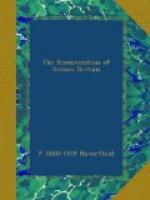If Professor Bury is right (Life of Patrick, p. 354), Riotamus had a predecessor in Dathi, who is said to have gone from Ireland to Gaul about A.D. 428 to help the Romans and Aetius. Zimmer (Nennius Vind., p. 85) rejects the tale. But it fits in well with the Celtic revival.]
This destruction of Romano-British life produced a curious result which would be difficult to explain if we could not assign it to this cause. There is a marked and unmistakable gap between the Romano-British and the Later Celtic periods. However numerous may be the Latin personal names and ‘culture words’ in Welsh, it is beyond question that the tradition of Roman days was lost in Britain during the fifth or early sixth century. That is seen plainly in the scanty literature of the age. Gildas wrote about A.D. 540, three generations after the Saxon settlements had begun. He was a priest, well educated, and well acquainted with Latin, which he once calls nostra lingua. He was also not unfriendly to the Roman party among the Britons, and not unaware of the relation of Britain to the Empire.[1] Yet he knew substantially nothing of the history of Britain as a Roman province. He drew from some source now lost to us—possibly an ecclesiastical or semi-ecclesiastical writer—some details of the persecution of Diocletian and of the career of Magnus Maximus.[2] For the rest, his ideas of Roman history may be judged by his statement that the two Walls which defended the north of the province—the Walls of Hadrian and Pius—were built somewhere between A.D. 388 and 440. He had some tradition of the coming of the English about 450, and of the reason why they came. But his knowledge of anything previous to that event was plainly most imperfect.
[Footnote 1: Mommsen, Preface to Gildas (Mon. Germ. Hist.), pp. 9-10. Gildas is, however, rather more Celtic in tone than Mommsen seems to allow. Such a phrase as ita ut non Britannia sed Romania censeretur implies a consciousness of contrast between Briton and Roman. Freeman (Western Europe, p. 155) puts the case too strongly the other way.]
[Footnote 2: Magnus Maximus, as the opponent of Theodosius, seems to have been damned by the Church writers. Compare the phrases of Orosius, vii. 35 (Theodosius) posuit in Deo spem suam seseque adversus Maximum tyrannum sola fide maior proripuit and ineffabili iudicio Dei and Theodosius victoriam Deo procurante suscipit.]
The Historia Brittonum, compiled a century or two later, preserves even less memory of things Roman. There is some hint of a vetus traditio seniorum. But the narrative which professes to be based on it bears little relation to the actual facts; the growth of legend is perceptible, and even those details that are borrowed from literary sources like Gildas, Jerome, Prosper, betray great ignorance on the part of the borrower.[1] On the other hand,




